In a previous blog post we discussed the use of common names for plants at the Arboretum and how they are totally fine and appropriate to use, as long as they are not xenophobic or derogatory. However, for staff at Hoyt Arboretum and others who work with hundreds of different plant species from around the world, we often prefer to use scientific names. Why do we do this, and what is all the hubbub about?
What is a scientific name, and where does it come from?
A scientific name is a unique name given to a species. All living organisms – mammals, insects, bivalves, fungi, bacteria, plants, etc. – have scientific names if they have been identified to species. A few facts about scientific names:
- They were formalized by C. Linnaeus in the mid-1700s when he created a hierarchical (ranked) system of classification for plants. In this system, plants that have common characteristics are grouped together, into increasingly higher levels of organization.
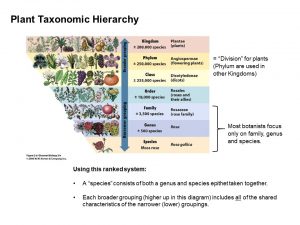

- Scientific names are mostly based on the Latin language and its grammar rules since Linnaeus first named plants using Latin. However, some plant names may have roots in Greek, Arabic, etc. so it is incorrect to refer to all scientific names as “Latin names.”
- There are precise rules for the naming of plants, and there are international bodies that oversee and regulate the naming of both wild and cultivated plants (see here and here).
- Scientific names are based on a history of Western colonialism. When Linnaeus initially created his naming system, he focused on plants from western Europe. Soon after, he sought to categorize and name all plants, receiving them from all over the world from naturalists and explorers and giving those plants names – often names that fit into his system, or naming new “discoveries” after explorers, colleagues and benefactors. After Linnaeus, other prominent botanists (at Kew Gardens, Arnold Arboretum at Harvard, New York Botanic Garden, etc.) continued with naming plants, most often without attributing indigenous people and their names and uses of those plants.
Even though there are disadvantages, why do plant nerds prefer to use scientific names?
People that work with many plant species at once, closely related species, or plants from different regions, benefit by and often prefer to use scientific names over common names because scientific names stay constant over time, across different regions and languages. (They do occasionally change, but this is a topic for a later blog!) For instance, botanists in North America can communicate with other scientists in Europe or Asia and would know exactly the plant species you are discussing if we use the names Linnaea borealis, Pteridium aquilinum, or Acer stachyophyllum, but might be puzzled if only their common names were used.
If you are an ecologist and are tasked with creating a restoration seed mix, you need to know the difference between your native and non-native fescue grasses. If you are a weed manager, you need to be sure that you are controlling and removing the correct weedy thistle, not a rare native one! Or, if you are plant nursery professional, it is important to know the differences between your maple species.
Additionally, by using scientific names, you can instantly tell something about that plant’s evolutionary relationship to other plants, based on its name alone.
What comprises a scientific name?
Scientific names are binomial, meaning that each species has a name of two parts: the genus and its species epithet. The genus name and species epithet taken together refer to one species.
- Genus (plural is genera) = A grouping of plants that has recognizable characteristics of all of the species included in that genus and that we can typically recognize as a named group of plants; i.e., a maple, magnolia, ash, rose, holly, etc.
- Species epithet = Indicates what type of that genus it is (e.g., a big leaf maple, a red maple, Japanese maple) and it can refer to something about what that plant looks like, the region where that plant is found, or if it is named for someone. For example, macrophyllum (large leaves), oreganum (from Oregon), or lewisii (named for explorer Meriweather Lewis).
A complete scientific name however – which are used in technical publications, but usually not for ordinary use – also includes the author name.
- Author name = Indicates the person who first named and/or described the species in a publication, so we can trace the history of that particular name.
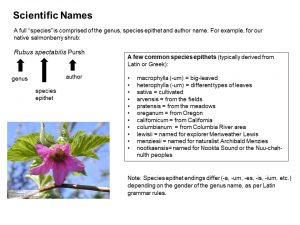

For example:
Acer rubrum L. – Indicates the genus Acer for maple, rubrum for red, and L. is an abbreviation for C. Linnaeus who first named the species. Therefore, red maple.
Berberis aquifolium Pursh – Genus Berberis for barberry, aquifolium for its holly-like leaves, and was named by F.T. Pursh. This is our state flower Oregon grape.
Abies lasiocarpa (Hook.) Nutt. – This is a true fir in the genus Abies, lasiocarpa means hairy-fruited or with densely pubescent cones (since conifers do not have true fruits), and the author name here is a bit more interesting. Joseph Hooker first named and described the plant, but it was later renamed (and the now currently accepted name) by Thomas Nuttall. This is our native subalpine fir tree.
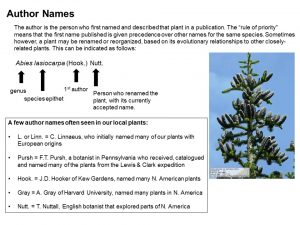

Details, details…
In casual use, such as when talking or when writing a list of scientific names, the author name is usually omitted. So we can just say Rubus spectabilis, Gaultheria shallon, or Berberis aquifolium when talking about our native shrubbery. When writing a scientific name properly, the genus is always capitalized, species epithet is lower case, and both are either underlined or in italics. If including the author name, it is not underlined or italicized. If there is a variety or subspecies (an even more-detailed level of organization within a species!), that name is italicized like the rest of the name, but the word variety or subspecies is not. For instance:
- Abies lasiocarpa var. lasiocarpa
- Pinus contorta ssp. contorta
- Pinus ponderosa var. benthamiana
If I love plants, do I have to use scientific names??
Of course not! Using scientific names is purely optional. It depends on your level of comfort, interest, and need to use them.
To recap: Yes, many geeky botanists (and others) prefer to use scientific names because they (supposedly) stay constant over time and across different regions, and a plant’s scientific name can instantly tell you something about its relationship to other plants. However, it is often much easier to use common names when conversing with others. At Hoyt Arboretum, we will continue to use both scientific and common names, and it is up you to decide what you prefer!
Lastly, a few of my favorite scientific names at Hoyt Arboretum
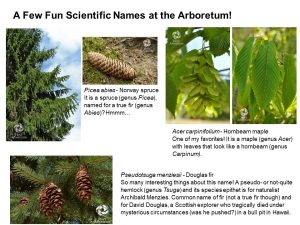

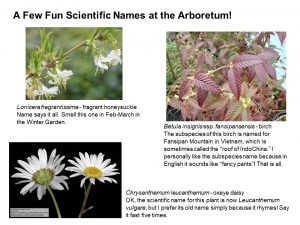

About the Author


Images from:
Taxonomic Hierarchy figure – Singh-Cundy, A. & G. Shin. 2006. Discover Biology. Norton & Company
Oregon Flora Project Photo Gallery
Hoyt Arboretum Plant Inventory
Betula insignis ssp. fansipansensis photo – Far Reaches Farm
Lonicera fragrantissima photo – K. Stüber
